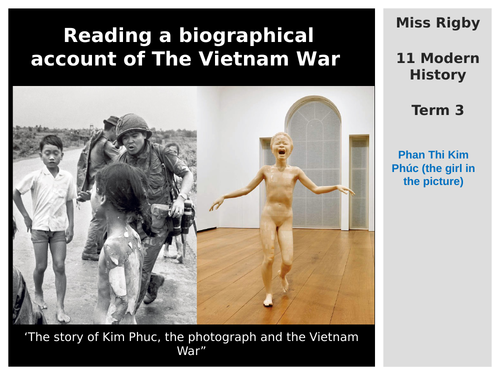


Two resources: a PowerPoint presentation and a lesson plan designed for use in a year 11 Modern History class. Within this lesson I revisited the historical concept of ‘empathy’ through the use of passages from a biography about Phan Thi Kim Phuc (who was caught in a NAPALM attack in 1972). By engaging with biographical sources I hoped to contextualize the experiences of those who lived in the past and to also encourage students to consider how historical conditions shaped the perspectives and decision-making of people who lived in Vietnam from 1945-1975. Lastly, I wanted them to be able to evaluate the relevance and reliability of biographical sources as they may come across these in their own research for their historical essay.
This PowerPoint includes a warm up (quick quiz) to settle students and to discern their prior knowledge. This is followed by some answer slides which include an explanation of why empathising is an important skill for historians. Afterwards there is a viewing activity to introduce students to the subject for today’s lesson and the infamous photograph taken of her. This video is used to broach a discussion about ‘perspective’ and what factors can shape a person’s perspective.
Subsequently, the differences between biography and autobiography are included on a slide side-by-side for comparison. This is useful for determining the level of reliability and usefulness of these two genres.
Following this, there are some dot points about the biography ‘The Girl in The Picture’ written by Denise Chong. There is information to establish what life was like for Kim Phuc’s family and how their life was impacted by the Vietnam War. There is an extract about her mother’s encounters with the Viet Cong on her way to and from work. These extracts show how civilians were impacted by the war and include descriptions of the modus operandi of the Viet Cong (a group which students may wish to research for their assessment). After reading the source and asking students what stood out to them from the passage, we talk about whether this source could be utilised in the assessment.
Students are asked to consider to what extent is it ‘useful’ and ‘reliable’. To help students learn how to articulate an evaluation, they are introduced to the terms ‘subjective’ and ‘objective.’ They are also provided with some information about the author Denise Chong and her writing process. This can help students make a more educated assessment of the source’s reliability.
This is followed by a discussion of how a historian might corroborate the information found in this source. A third extract (showing the photographer’s perspective) is provided as a point of contrast. This passage is useful for discussing writing techniques used as these are a means of evaluating source reliability (e.g. neutral vs persuasive, facts vs opinions).
Something went wrong, please try again later.
This resource hasn't been reviewed yet
To ensure quality for our reviews, only customers who have purchased this resource can review it
Report this resourceto let us know if it violates our terms and conditions.
Our customer service team will review your report and will be in touch.
